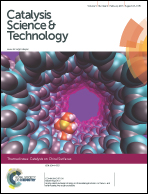Partial hydrogenation of acetylene over a NiTi-layered double hydroxide supported PdAg catalyst
Abstract
NiTi-layered double hydroxide (NiTi-LDH) with rich defective sites was synthesized and used as the support for the preparation of a novel supported PdAg nanoalloy catalyst for the partial hydrogenation of acetylene. The obtained PdAg/NiTi-LDH catalyst exhibited a remarkable catalytic performance. When the conversion of acetylene reached 90%, the selectivity towards ethene maintained 82%. Superior hydrogenation activity was ascribed to two key factors. Small particle size and high dispersion of PdAg nanoparticles were responsible for boosting the catalytic activity. In addition, Ti3+ defective sites in the support also played an important role in the enhancement of activity. The interface at the Ti3+ species and active metals acting as new active sites enhanced the activation and dissociation of hydrogen and therefore further improved the catalytic activity. Preferable selectivity was assigned to the electronic effect between the NiTi-LDH support and the PdAg nanoalloys. The electron transfer from the Ti3+ species to the Pd resulted in the increase of electron density and the linearly coordinated sites of Pd and therefore facilitated the desorption of ethene. Moreover, due to the reducibility of NiTi-LDH, the selectivity and stability over the reduced PdAg/NiTi-LDH catalyst were further enhanced on account of the strong metal–support interaction.


 Please wait while we load your content...
Please wait while we load your content...